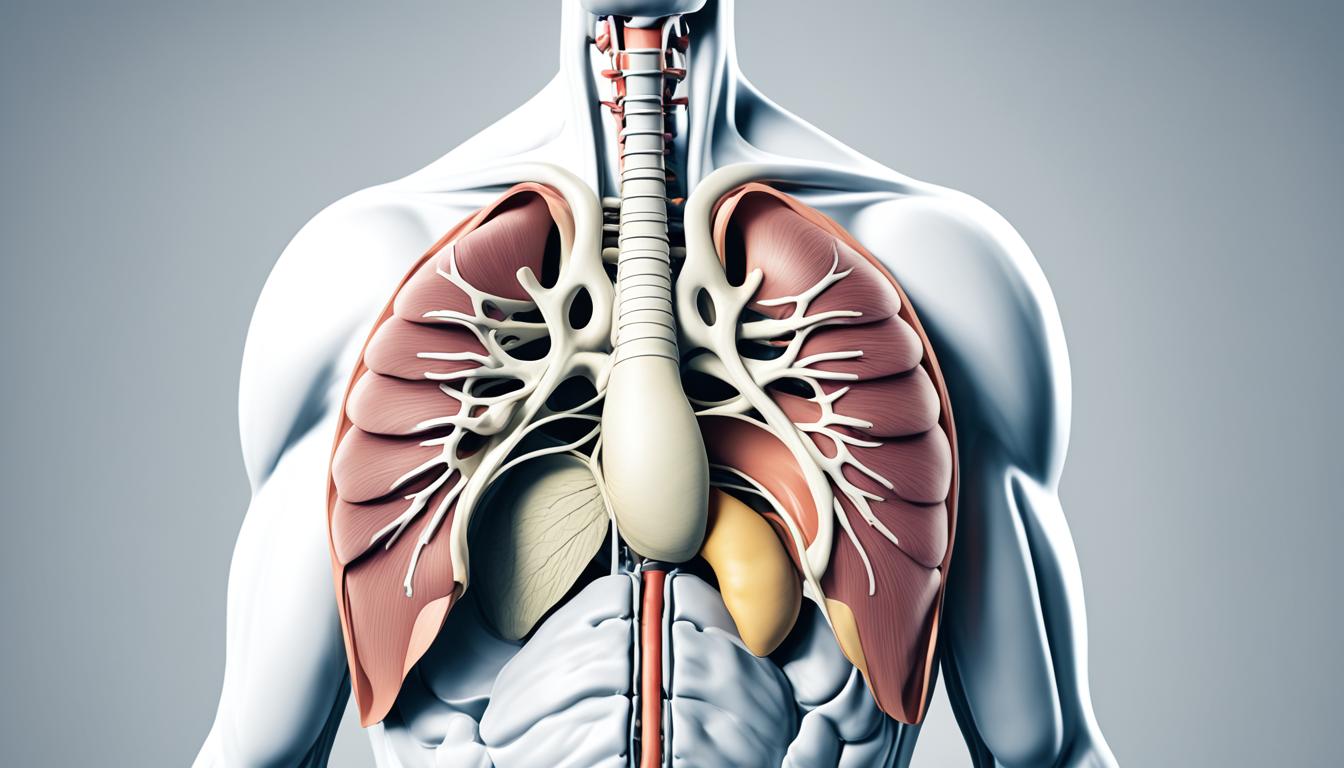Congenital diaphragmatic hernia (CDH) affects newborns, causing a hole in the diaphragm. This lets organs move into the chest, making lungs underdeveloped. Babies with CDH face trouble breathing. It’s found during pregnancy with special scans or after birth when breathing is hard. All babies with CDH need surgery. This fixes the diaphragm and puts organs back in place.
In the UK, about 1 baby in 5,000 gets CDH. It happens equally to boys and girls. Seventy percent of CDH babies survive, but tough cases may be deadly. They could even lead to a loss before birth or soon after.
Key Takeaways:
- Congenital diaphragmatic hernia (CDH) affects babies with a hole in their diaphragm.
- This hole lets organs move into the chest, affecting the lungs.
- Common symptoms are underdeveloped lungs and breathing issues.
- It is found early during pregnancy or right after birth.
- All CDH babies need surgery to fix their diaphragm and place organs rightly.
CDH is a serious issue needing quick medical care and special treatment. We will look at how it’s treated and the baby’s future. Also, we will explore using stem cells to help treat CDH and make outcomes better for these babies.
CDH Treatment Options – Surgery, Ventilator, Oscillation, ECMO
Healthcare professionals use different methods to treat Congenital Diaphragmatic Hernia (CDH). They aim for the best possible when working with affected babies. CDH treatment includes surgery, use of a ventilator, oscillation, and, in extreme cases, ECMO.
CDH Surgery: Doctors perform surgery when the baby is stable. This surgery moves organs from the chest to the belly. It also fixes the hole in the diaphragm. Surgery is done early in life, often in the first few days.
Ventilator Support: Babies with CDH often need help breathing. A ventilator provides this support, ensuring their lungs get enough oxygen to heal and grow.
Oscillation Ventilation: Oscillation is used when high lung pressures are needed. It sends quick bursts of air into the lungs. This helps improve how well the lungs work and oxygen levels.
ECMO (Extracorporeal Membrane Oxygenation): For the most serious CDH cases, ECMO is a crucial treatment. ECMO functions outside the body to add oxygen to the blood while taking out carbon dioxide. It’s a temporary fix for babies with severe heart and lung problems.
Doctors might use a mix of these treatments for CDH. They choose the best mix depending on the baby’s health and how severe the CDH is. The main goal is to help these babies live and grow healthily.
CDH Treatment Options Comparison
| Treatment Option | Description |
|---|---|
| Surgery | Organs moved from chest to abdomen, repair of diaphragmatic hole |
| Ventilator Support | Assists with breathing, ensures sufficient oxygenation of lungs |
| Oscillation Ventilation | Rapid delivery of small-volume air pulses to enhance lung function |
| ECMO | Specialized treatment for severe heart and lung conditions |
Prognosis and Long-Term Outlook for CDH Survivors
The chances of a baby with Congenital Diaphragmatic Hernia (CDH) living long vary. This depends on the condition’s severity, the complications it brings, and the treatment response. The outlook for CDH survivors has got better. But, they may still face big challenges. It is essential to know this.
Common Problems and Complications
After CDH treatment, babies may face many issues growing up. A rare problem that could happen is the hernia coming back. In these cases, a second surgery might be needed.
Gastroesophageal reflux (GERD) is common in these babies. It’s when stomach acid moves back into the throat. This can be uncomfortable and cause health problems. Medicine and lifestyle changes can help. But sometimes, surgery is needed.
CDH survivors might have trouble breathing. Some could need oxygen or other help to breathe well. They must have regular visits with their doctors to look after their lungs.
Babies needing ECMO for CDH might face more hearing problems. It’s key to check their hearing often. If there’s a hearing issue, it’s best to deal with it early.
CDH Support Resources
Families dealing with CDH need good information and support. CDH UK is a great place to go for help. They offer information, support groups, fundraising, and updates. This helps both parents and medical teams.
| CDH Support Resources | Description | Contact Information |
|---|---|---|
| CDH UK | Offers information, support, and resources for families affected by CDH. | Website: https://www.cdhuk.org.uk/ Email: [email protected] Phone: +44 1234 567890 |
Using resources like CDH UK can make a big difference. Families can get the help and understanding they need. Connecting with others in similar situations is very valuable. These supports help improve the life of CDH survivors.
Conclusion
Despite medical advances, Congenital Diaphragmatic Hernia (CDH) is still hard to treat, with a high chance of death. Stem cell therapy offers hope by aiming to make things better. There’s ongoing research and clinical trials looking into this new treatment for CDH.
Stem cell therapy could better lung growth and function in CDH babies. Yet, we still need more research to be sure of its benefits and downsides. With time and more studies, using stem cells could offer better ways to treat CDH and help affected babies in the long run.

